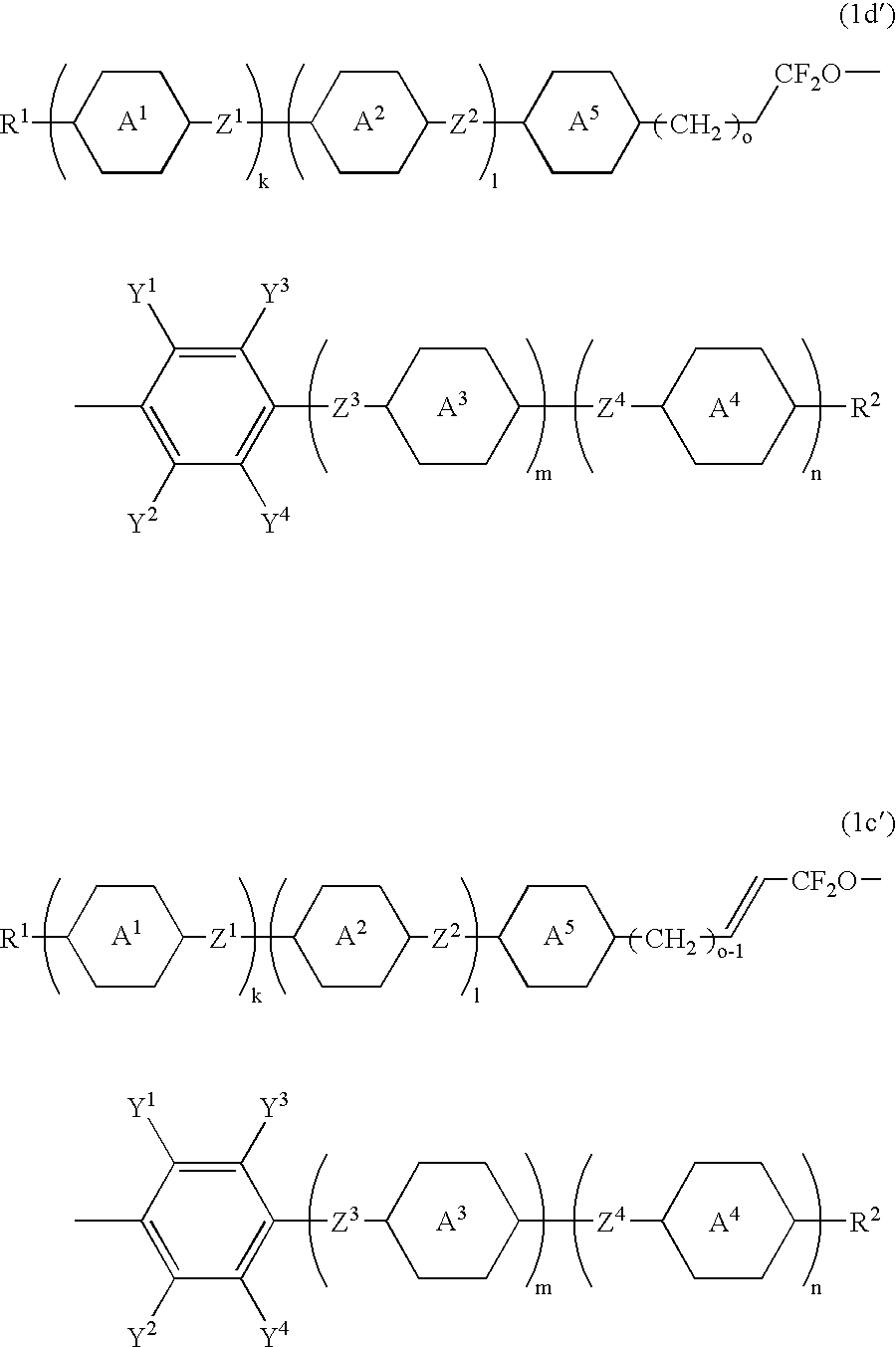Difluoromethyl ether derivative and process for producing the same
a technology of difluoromethyl ether and ether derivative, which is applied in the field of difluoromethyl ether derivative, can solve the problems of unsatisfactory yield and the process is not necessarily simple and efficient for producing difluoromethyl ether derivative, and achieves simple and efficient process, high yield, and high yield
- Summary
- Abstract
- Description
- Claims
- Application Information
AI Technical Summary
Benefits of technology
Problems solved by technology
Method used
Image
Examples
example 1
Production of 1-(trans-4-(trans-4-propylcyclohexyl)cyclohexyldifluoromethoxy)-3,4,5-trifluorobenzene (the compound (1d), wherein k is 1, and l, m and n are 0; R1 is n-propyl; ring A1 is trans-1,4-cyclohexylene; Z1 is a single bond; both Y1 and Y2 are hydrogen; and all of Y3, Y4 and R2 are fluorine (Compound No. 17))
Production of Starting Material, Compound (1a)
In a nitrogen-purged 1-L three-neck flask equipped with a stirrer, a thermometer and a dropping funnel, 49.7 g (0.23 mol) of dibromodifluoromethane was dissolved in 100 ml of THF and the solution was cooled down to −20° C. while stirring. 117 g (0.47 mol) of tris(diethylamino)phosphine dissolved in 200 ml of THF was added dropwise at 10° C. or lower, and then the solution was stirred at room temperature for one hour. Next, 35 g (0.16 mol) of 4-(trans-4-propylcyclohexyl)cyclohexanone dissolved in 100 ml of THF was added dropwise at 30° C. or lower, and then the solution was stirred at room temperature for 6 hours. The reaction ...
example 2
Production of 1-(trans-4-(trans-4-pentylcyclohexyl)cyclohexyldifluoromethoxy)-4-trifluoromethoxybenzene (a compound (1d), wherein k is 1, and l, m and n are 0; R1 is n-pentyl; ring A1 is trans-1,4-cyclohexylene; Z1 is a single bond; all of Y1, Y2, Y3 and Y4 are hydrogen; and R2 is trifluoromethoxy (Compound No. 18))
First Step
A nitrogen-purged 100-ml three-neck flask equipped with a stirrer, a thermometer and a condenser was charged with 8.0 g (28.1 mmol) of 4-(trans-4-pentylcyclohexyl)-α,α-difluorocyclohexylidene obtained by the same method of preparing the compound (1a) in Example 1 and 24.2 g (140.7 mmol) of 47% hydrobromic acid, and the solution was heated under reflux for 5 hours. The reaction mixture was transferred into a 1-L beaker, and 150 ml of water and 200 ml of heptane were added thereto. The separated heptane layer was washed three times with 150 ml of water and dried over anhydrous magnesium sulfate. The solvent was distilled off under reduced pressure, and then the co...
example 3
Production of 1-(3-(trans-4-(trans-4-pentylcyclohexyl)cyclohexyl)-1,1-difluoro-2-propenyloxy)-3,4,5-trifluorobenzene (a compound (1c′), wherein k is 1; l, m and n are 0; o is 1; R1 is n-pentyl; both ring A1 and ring A5 are trans-1,4-cyclohexylene; Z1 is a single bond; both Y1 and Y2 are hydrogen; and all of Y3, Y4 and R2 are fluorine (Compound No. 105))
Production of Starting Material, Compound (1a′)
A nitrogen-purged 1-L three-neck flask equipped with a stirrer, a thermometer and a dropping funnel was charged with 16.4 g (107.7 mmol) of sodium chlorodifluoroacetate, 28.3 g (107.7 mmol) of triphenylphosphine and 200 ml of DMF, and the mixture was heated up to 80° C. while stirring. A solution of 15.0 g (53.9 mmol) of 1-(trans-4-(trans-4-pentylcyclohexyl)cyclohexyl)acetaldehyde dissolved in 100 ml of DMF was added dropwise at 80 to 110° C., and the solution was stirred at 100° C. for 2 hours. The reaction mixture was transferred into a 2-L beaker, and 500 ml of heptane was added theret...
PUM
| Property | Measurement | Unit |
|---|---|---|
| optical anisotropy | aaaaa | aaaaa |
| dielectric anisotropy | aaaaa | aaaaa |
| threshold voltage | aaaaa | aaaaa |
Abstract
Description
Claims
Application Information
 Login to View More
Login to View More - R&D
- Intellectual Property
- Life Sciences
- Materials
- Tech Scout
- Unparalleled Data Quality
- Higher Quality Content
- 60% Fewer Hallucinations
Browse by: Latest US Patents, China's latest patents, Technical Efficacy Thesaurus, Application Domain, Technology Topic, Popular Technical Reports.
© 2025 PatSnap. All rights reserved.Legal|Privacy policy|Modern Slavery Act Transparency Statement|Sitemap|About US| Contact US: help@patsnap.com



